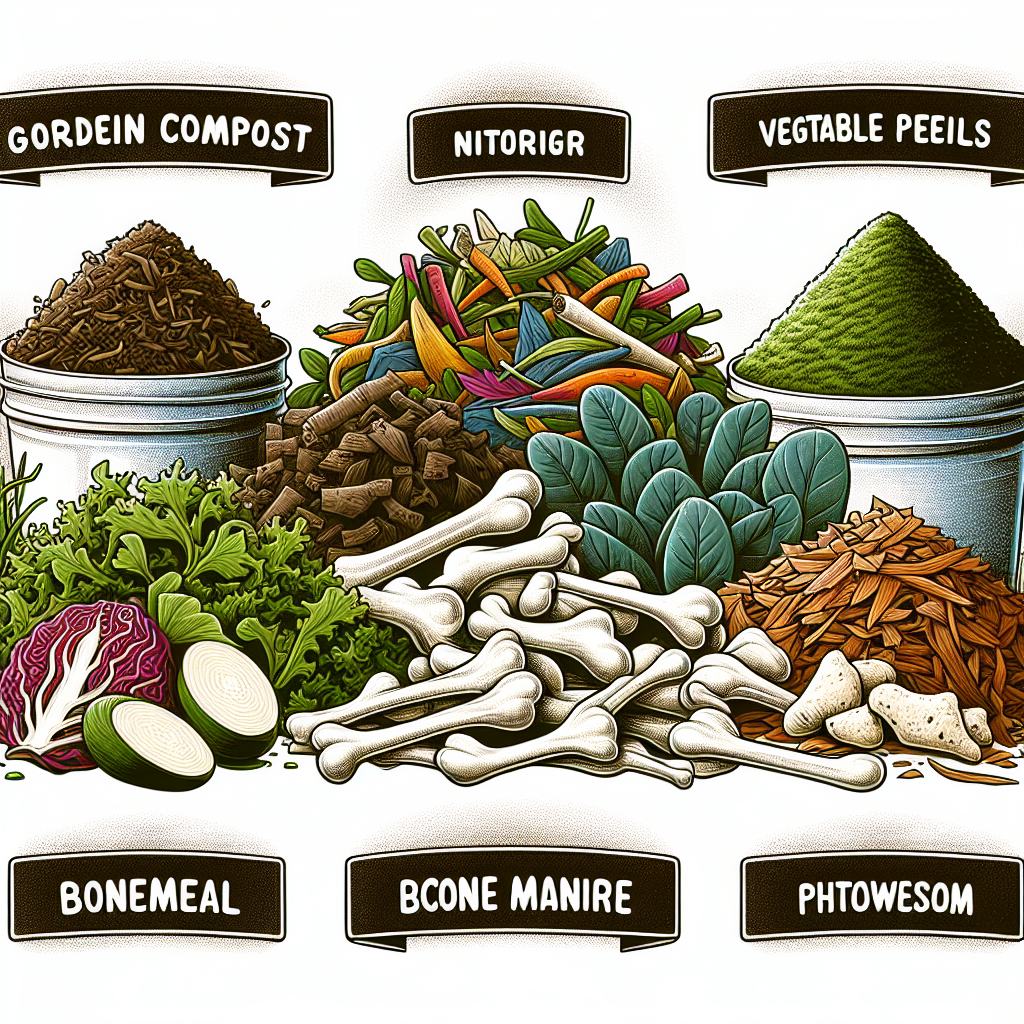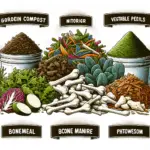Introduction
Welcome to our comprehensive guide on how to make organic fertilizer. In this detailed resource, we will explore the various methods and benefits of creating your own organic fertilizer for a greener and more sustainable approach to gardening and agriculture.
The Importance of Organic Fertilizers
Organic fertilizers play a vital role in enhancing soil fertility and promoting healthier plant growth. Unlike synthetic fertilizers, organic fertilizers are derived from natural sources, making them safe for the environment, plants, and ultimately, the consumers of the produce.
Benefits of Making Your Own Organic Fertilizer
- Cost-Effective: Creating your own organic fertilizer can be a budget-friendly alternative to buying commercial products.
- Sustainability: By recycling organic waste into fertilizer, you contribute to a sustainable and eco-friendly gardening approach.
- Customization: Homemade organic fertilizers allow you to tailor the nutrients according to specific plant requirements.
What This Guide Covers
This guide will provide step-by-step instructions, valuable tips, and creative recipes to empower you to craft your own organic fertilizer blends. Whether you are an experienced gardener or a novice enthusiast, this resource is designed to assist you in mastering the art of organic fertilization. Let’s delve into the fascinating world of organic gardening together!
Importance of Organic Fertilizer
Organic fertilizer plays a vital role in sustainable agriculture, providing numerous benefits for both the environment and the crops being grown. Let’s explore the significance of using organic fertilizer:
1. Environmental Impact
Organic fertilizer is derived from natural sources such as compost, manure, and other organic materials. It helps in maintaining soil structure, retaining moisture, and promoting biodiversity in the soil.
2. Nutrient-Rich Soil
Organic fertilizers are rich in essential nutrients such as nitrogen, phosphorus, and potassium. These nutrients are released slowly, providing a steady and long-lasting food source for plants.
3. Reduced Chemical Exposure
By using organic fertilizers, farmers can minimize chemical exposure to both the environment and consumers. This promotes healthier ecosystems and reduces the risk of toxic residues in food products.
4. Enhancing Soil Fertility
Organic fertilizers improve soil fertility by promoting microbial activity and earthworm populations. This leads to better soil aeration, nutrient uptake, and overall plant health.
5. Sustainable Agriculture
Embracing organic fertilizers is a step towards sustainable agriculture. It supports the natural nutrient cycle, reduces dependency on synthetic inputs, and contributes to long-term soil health.
Benefits of Making Your Own Organic Fertilizer
The Essence of Organic Fertilizer
Organic fertilizer is a vital component for enriching soil and promoting plant growth in a natural, sustainable manner. By creating your own organic fertilizer, you take control of the ingredients, ensuring a chemical-free, environmentally friendly approach to gardening.
Key Advantages
- Nutrient-Rich: Homemade organic fertilizers are packed with essential nutrients that improve soil health and enhance plant growth.
- Cost-Effective: Crafting your own fertilizer can be a budget-friendly alternative to purchasing commercial products, saving money in the long run.
- Customizable Formulas: Tailor your fertilizer mix to suit specific plant needs, ensuring optimal growth and overall health.
- Sustainable Practice: By recycling kitchen scraps and other organic materials, you contribute to reducing waste and promoting sustainability.
Environmental Impact
The use of organic fertilizers supports biodiversity in soil, promoting a healthy ecosystem and reducing the risk of chemical run-off into water sources. This eco-friendly approach benefits not only your garden but the environment as a whole. As Wendell Berry famously said, “The soil is the great connector of our lives, the source and destination of all.”
Environmental Impact
The Importance of Environmental Considerations
When it comes to producing organic fertilizer, it is crucial to consider the environmental impact of the entire process. Environmental sustainability is at the core of organic farming practices, and making organic fertilizer should be no exception.
Reduced Chemical Pollution
Unlike synthetic fertilizers, organic fertilizers do not contain harmful chemicals that can leach into the soil and water sources, reducing the risk of pollution and protecting the environment for future generations.
Enhancing Soil Health
Organic fertilizers improve soil structure and enhance soil biodiversity, fostering a healthy ecosystem underground. This promotes long-term sustainability and reduces the need for chemical interventions.
Carbon Footprint
Producing organic fertilizer typically has a lower carbon footprint compared to manufacturing synthetic fertilizers. By utilizing organic waste and natural ingredients, we can reduce greenhouse gas emissions and combat climate change.
Quote
“By prioritizing environmental impact in our fertilizer production, we are not just growing crops, we are nurturing the planet.”
Summary
Considering the environmental impact of organic fertilizer production is not just a choice; it is a responsibility we owe to the earth and future generations. Through sustainable practices and mindful decisions, we can create a greener, healthier world.
Cost-effectiveness
When it comes to organic fertilizer, considering cost-effectiveness is crucial. Let’s delve into how you can make the most out of your resources while maintaining high-quality soil nutrition.
The Economics of Organic Fertilizer
Organic fertilizers may have a higher upfront cost compared to their synthetic counterparts. However, their long-term benefits often outweigh this initial investment.
Factors Influencing Cost-effectiveness
- Ingredients: Utilizing locally sourced and in-house compost materials can significantly reduce expenses.
- Application: Correctly applying organic fertilizer at the right time and in the right amounts can optimize its effectiveness, ensuring you get the most out of each application.
- Soil Health: Improving soil health through organic practices can lead to reduced dependency on external inputs, ultimately saving costs in the long run.
Quotes on Value and Affordability
“Investing in organic fertilizer is not just about cost, it’s about the value it brings to your soil and crops.”
Case Study: Cost Comparison
| Input | Organic Fertilizer | Synthetic Fertilizer |
|---|---|---|
| Cost per Bag | $20 | $15 |
| Application Frequency | Monthly | Bi-weekly |
| Annual Cost | $240 | $390 |
Despite the higher cost per bag, organic fertilizer proves to be more cost-effective in the long term due to its less frequent application requirements and overall soil health benefits.
Understanding the Basics of Organic Fertilizer
Organic fertilizers play a crucial role in promoting healthy plant growth while enriching the soil naturally. Let’s delve into the fundamental aspects of organic fertilizers that every gardening enthusiast should grasp.
The Essence of Organic Fertilizer
Organic fertilizer is derived from natural sources, such as plants, animals, or minerals, and is free from synthetic additives. It nourishes the soil and plants with essential nutrients in a sustainable manner.
Key Components of Organic Fertilizer
- Macronutrients: Organic fertilizers contain primary nutrients like nitrogen, phosphorus, and potassium (N-P-K), vital for plant growth.
- Micronutrients: These include iron, zinc, and calcium, which are necessary for plant health but required in smaller quantities.
- Organic Matter: Composed of decomposed plants or animal residues, it enhances soil structure and fertility.
Advantages of Organic Fertilizers
- Improves soil structure and water retention capabilities.
- Enhances microbial activity vital for nutrient uptake.
- Minimizes the risk of chemical build-up in soil over time.
Application Techniques
When using organic fertilizers, proper application techniques are essential for optimal results. Consider factors such as soil type, plant requirements, and the appropriate dosage to avoid over-fertilization.
Organic vs. Synthetic Fertilizers
Organic fertilizers offer sustainable, long-term benefits to both plants and the environment, unlike synthetic alternatives that may cause soil degradation and harm beneficial soil organisms.
Choosing the Right Organic Fertilizer
It’s crucial to select the appropriate organic fertilizer based on your plant’s specific needs, ensuring a balanced nutrient supply without chemicals that could harm the ecosystem.
Nutrient Requirements for Plants
Plants, like all living organisms, require a variety of nutrients to thrive and grow. Understanding the specific nutrient requirements of plants is essential for successful gardening and agriculture.
Essential Nutrients
Plants require several essential nutrients to support their growth and development. These nutrients are categorized into two groups:
- Macro Nutrients: These are required by plants in relatively large quantities and include nitrogen, phosphorus, potassium, calcium, magnesium, and sulfur.
- Micro Nutrients: Although needed in smaller amounts, micro nutrients such as iron, manganese, zinc, copper, boron, and molybdenum are equally important for plant health.
Understanding Nutrient Functions
Each nutrient plays a unique role in the plant’s overall health and functionality. For example:Nitrogen: Essential for leaf growth and overall plant vigor. Phosphorus: Promotes root development and flowering. Potassium: Helps in disease resistance and overall plant strength.
Organic Sources of Nutrients
Organic fertilizers are an excellent way to provide plants with the necessary nutrients in a natural and sustainable manner. Some common organic sources of nutrients include:
- Compost: Rich in organic matter, providing a balanced array of nutrients.
- Bone Meal: A good source of phosphorus, essential for flowering plants.
- Fish Emulsion: High in nitrogen and other trace elements beneficial for plant growth.
Applying Nutrients
It is essential to apply nutrients correctly to ensure optimal plant uptake and minimize nutrient loss. Consider factors such as soil type, plant type, and growth stage when applying fertilizers to maximize their effectiveness.
Remember, a well-balanced nutrient supply is key to healthy and vibrant plants.
Types of Organic Materials
1. Plant-Based Materials
Plant-based materials are a vital component of organic fertilizers, providing essential nutrients for plant growth. Some common plant-based materials include:
- Compost
- Manure
- Alfalfa meal
- Cottonseed meal
2. Animal-Based Materials
Animal-based materials are rich in nitrogen and are valuable for enriching the soil. Key examples of animal-based materials are:
- Blood meal
- Bone meal
- Fish emulsion
- Poultry manure
3. Mineral-Based Materials
Mineral-based materials are another crucial type of organic material that provides essential minerals for plant growth. Some mineral-based materials include:
- Rock phosphate
- Greensand
- Kelp meal
- Oyster shell
4. Microorganism-Based Materials
Microorganism-based materials play a significant role in enhancing soil fertility and plant health through the introduction of beneficial microorganisms. Some examples of microorganism-based materials are:
- Compost tea
- Biochar
- Microbial inoculants
- Worm castings
Popular Ingredients for Organic Fertilizer
When it comes to creating organic fertilizer, selecting the right ingredients is crucial. Here are some popular choices that can help enrich your soil naturally:
1. Compost
Compost is a powerful organic fertilizer made from decomposed organic matter such as kitchen scraps, yard waste, and manure. It is rich in essential nutrients and beneficial microorganisms, making it a staple for many gardeners.
2. Manure
Manure from animals like cows, horses, chickens, and rabbits is another common ingredient in organic fertilizers. It is high in nitrogen, phosphorus, and potassium, essential for plant growth.
3. Bone Meal
Bone meal is a natural source of phosphorus and calcium derived from finely ground animal bones. It’s particularly beneficial for flowering plants and root development.
4. Fish Emulsion
Fish emulsion is a potent liquid fertilizer made from fish waste. It is a quick-release source of nutrients like nitrogen and trace minerals, ideal for promoting lush green growth.
5. Seaweed
Seaweed or seaweed extract is a nutrient-rich ingredient that enhances plant growth and improves soil structure. It contains an array of trace minerals and growth hormones beneficial for overall plant health.
These are just a few examples of the many ingredients you can use to create your own organic fertilizer blend. Experimenting with different combinations can help you tailor the nutrients to the specific needs of your plants.
Kitchen Scraps
When it comes to creating organic fertilizer, kitchen scraps are a valuable resource that often goes to waste. By repurposing these scraps, you can contribute to a more sustainable and eco-friendly gardening practice. Let’s explore how you can effectively utilize kitchen scraps in making organic fertilizer.
Types of Kitchen Scraps to Use:
- Fruit and Vegetable Peels: Rich in nutrients and easy to collect.
- Coffee Grounds: Adds nitrogen to the compost.
- Eggshells: Provide calcium to the soil.
- Tea Bags: Break down easily and enrich the compost.
Composting Process:
Creating compost from kitchen scraps involves layering organic materials to facilitate decomposition. Aim for a mix of “green” (nitrogen-rich) and “brown” (carbon-rich) materials to maintain a balanced compost pile.
- Layering: Alternate between kitchen scraps and dry materials like leaves or shredded paper.
- Turning: Aerating the compost helps speed up decomposition.
- Monitoring Moisture: The compost should be damp but not soggy.
Benefits of Using Kitchen Scraps:
“Turning kitchen waste into nutrient-rich compost is a rewarding way to close the sustainable gardening loop.”
By diverting kitchen scraps from landfills and transforming them into fertilizer, you not only reduce waste but also enhance soil health. The resulting compost is a natural and cost-effective way to nourish your plants and promote a thriving garden ecosystem.
Grass Clippings
Benefits of Using Grass Clippings in Organic Fertilizer
Grass clippings are a valuable resource that can be repurposed into organic fertilizer, providing numerous benefits for your garden or plants. When used correctly, grass clippings can enhance soil quality and promote healthier growth.
Key Nutrients in Grass Clippings
Grass clippings contain essential nutrients such as nitrogen, potassium, and phosphorus, which are vital for plant growth and development. These nutrients can enrich the soil and improve overall fertility, acting as a natural fertilizer for your garden.
Best Practices for Incorporating Grass Clippings
- Allow the grass clippings to dry out before applying them to the soil to prevent matting and potential odor issues.
- Spread a thin layer of grass clippings over the soil surface to avoid smothering your plants.
- Mix the grass clippings into the soil to encourage decomposition and release nutrients gradually.
- Avoid using grass clippings that have been treated with herbicides or pesticides to maintain the organic integrity of your fertilizer.
Quotes on Grass Clippings
“Grass clippings are a green and sustainable way to nourish your plants while reducing waste in your yard.” – Gardening Expert
Eggshells
Eggshells are a valuable resource for creating organic fertilizer. Their rich calcium content is beneficial for plants, helping with root development and overall growth. Learn how to utilize eggshells in your gardening practices.
Benefits of Eggshells in Fertilizer
- Calcium Boost: Eggshells provide a natural source of calcium, essential for plant health.
- Slow Release: When crushed finely, eggshells release nutrients gradually, promoting long-term plant vitality.
- PH Balance: Eggshells help regulate soil pH levels, creating a favorable environment for many plants.
How to Prepare Eggshells for Fertilizer
- Collecting: Save eggshells after cooking or baking to accumulate a sufficient amount.
- Cleaning: Rinse the eggshells with water and let them air-dry completely.
- Crushing: Crush the dried eggshells into small pieces or grind them into a fine powder.
Using Eggshells in Fertilizer
There are several ways to incorporate eggshells into your organic fertilizer:
“Sprinkle crushed eggshells directly into the soil around plants or mix powdered eggshells into compost for added nutrients.”
Experiment with different methods to find what works best for your gardening needs.
Step-by-Step Guide to Making Organic Fertilizer
Creating your own organic fertilizer is an enriching experience that promotes sustainability in gardening practices. By following these steps, you can produce a nutrient-rich blend that will nourish your plants and promote a healthy ecosystem in your garden.
Gathering Ingredients
- Organic Matter: Collect kitchen scraps, yard waste, and other organic materials.
- Manure: Use well-aged animal manure from herbivores like cows, horses, or rabbits.
- Green Matter: Include grass clippings, vegetable scraps, or coffee grounds.
Building the Compost Pile
- Layering: Alternate between organic matter, manure, and green matter for a balanced mix.
- Moisture: Ensure the pile remains moist but not waterlogged for proper decomposition.
- Aeration: Turn the pile regularly to aerate it and aid in the breakdown process.
Composting Process
- Patience: Composting can take several weeks to several months, depending on environmental factors.
- Monitoring: Check the temperature and moisture levels regularly to ensure proper decomposition.
- Turning: Turn the compost pile every few weeks to speed up the process.
Application
Once the compost is dark, crumbly, and earthy-smelling, it is ready to use.
“Compost is the gardener’s black gold, enriching the soil and fostering plant growth naturally.“
Spread the organic fertilizer around your plants, mixing it into the soil to provide essential nutrients slowly over time.
Collecting Organic Materials
When it comes to creating organic fertilizer, the first step is to gather high-quality organic materials. This essential process sets the foundation for producing nutrient-rich compost that will benefit your plants and the environment.
Gathering Process
Collecting organic materials can be an enriching experience that connects you with nature. Here are some key points to consider:
- Selection: Choose a variety of organic materials such as kitchen scraps, yard waste, and plant trimmings to create a balanced compost mix.
- Quality: Ensure the materials collected are free from pesticides and chemicals to maintain the organic integrity of the compost.
- Quantity: Collect a sufficient amount of materials to create a compost pile that generates enough heat for proper decomposition.
Best Practices
Following these best practices will contribute to the success of your organic fertilizer production:
“The key to effective composting lies in the mindful selection and assembly of organic materials, creating a harmonious blend that nurtures the soil and promotes plant growth.”
| Material Type | Guidelines |
|---|---|
| Kitchen Scraps | Include fruit and vegetable peels, coffee grounds, and eggshells |
| Yard Waste | Use grass clippings, leaves, and small twigs |
| Plant Trimmings | Add pruned branches, flowers, and weeds |
With a mindful approach to collecting organic materials and a commitment to sustainable practices, you can create nutrient-dense organic fertilizer that nourishes your garden and fosters a greener planet.

Creating a Compost Pile
Choosing the Right Spot
When setting up your compost pile, select a location that receives a good amount of sunlight and is easily accessible for regular maintenance.
Gathering Materials
Collect a mix of green materials (such as fruit scraps and grass clippings) and brown materials (like dried leaves and cardboard). Balance is key to successful decomposition.
Building the Pile
Start the pile with a layer of browns, followed by a layer of greens, and continue layering until reaching the desired height. Ensure each layer is moistened but not soggy.
Turning and Aerating
Regularly turning the compost pile helps aerate it, providing the necessary oxygen for decomposition. Aim to turn the pile every couple of weeks.
Monitoring and Troubleshooting
Check the compost pile regularly for moisture levels and temperature. Adjust as needed by adding more browns for moisture or turning the pile if it’s not heating up.
Harvesting the Compost
Once the materials have broken down into a dark, crumbly substance, your compost is ready to use. Harvest it by removing the bottom layer of the pile and use it to enrich your soil.
Turning the Compost
Turning your compost pile is a crucial step in ensuring successful decomposition and a nutrient-rich end product. This process helps aerate the pile, maintain proper moisture levels, and distribute microorganisms evenly.
Frequency of Turning
Turning the compost every 1-2 weeks is generally recommended to promote decomposition and prevent unpleasant odors. However, the frequency may vary based on factors like moisture content and the type of materials used.
Techniques for Turning
- Using a pitchfork or shovel: Insert the tool into the pile and lift and turn the materials to introduce air.
- Turning pile into a new bin: If feasible, transfer the materials into a new bin while turning to mix thoroughly.
Observing the Compost
During the turning process, observe the compost’s consistency. It should resemble a dark, crumbly material with an earthy smell. Adjust the moisture levels by adding water or dry materials as needed to maintain proper balance.
Troubleshooting
Foul Odors: If your compost smells foul, it may indicate anaerobic conditions. Increase turning frequency and add brown materials like dry leaves. Slow Decomposition: Slow decomposition could result from lack of aeration or moisture. Turn the pile more frequently and ensure proper moisture levels.
Curing the compost
Once the composting process is complete, it’s time to cure the compost to ensure it is fully matured and ready for use in your garden. Curing the compost is a crucial step that allows for the breakdown of any remaining organic matter and for the compost to stabilize before application.
Importance of Curing
Curing the compost enhances its quality by allowing beneficial microbes to further break down the materials, resulting in a nutrient-rich end product. This process also helps in reducing the chances of any harmful pathogens that may be present in the raw materials.
Duration of Curing
The duration for curing compost can vary depending on factors like the initial composition of the materials and the environmental conditions. On average, curing can take anywhere from a few weeks to a few months.
Optimal Curing Conditions
- Aeration: Turning the compost regularly during the curing process helps maintain aerobic conditions and speeds up decomposition.
- Moisture: Keep the compost moist but not waterlogged to support microbial activity.
- Temperature: Maintain a moderate temperature range for effective curing, ideally between 110°F to 140°F (43°C to 60°C).
Testing for Readiness
One way to test if the compost is fully cured is by its appearance and smell. Well-cured compost should have an earthy smell and a crumbly, dark texture. It should no longer have a strong odor or be warm to the touch, indicating that the curing process is complete.
Storage of Cured Compost
Once the compost is adequately cured, it can be stored in a covered bin or directly applied to the soil in your garden. Properly stored compost maintains its nutrient value for an extended period, ready to enrich your plants.
Using Your Homemade Organic Fertilizer
Application Tips
Applying homemade organic fertilizer to your plants is a rewarding experience that requires care and attention to achieve optimal results. Here are some tips to make the most of your fertilizer:
- Apply fertilizer in the early morning or late afternoon to prevent the sun from drying it out too quickly.
- Water your plants before and after applying the fertilizer to help with nutrient absorption.
- Follow the instructions for application rates to avoid over-fertilizing your plants.
Frequency of Use
The frequency of using your homemade fertilizer depends on the type of plants and the current growing season. Generally, applying fertilizer every 4-6 weeks during the growing season will suffice. However, be attentive to your plants’ needs and adjust the frequency accordingly.
Storage Guidelines
Proper storage of your homemade organic fertilizer is crucial to maintain its effectiveness. Follow these guidelines:
- Store the fertilizer in a cool, dry place away from direct sunlight.
- Keep the fertilizer in an airtight container to prevent moisture from affecting its quality.
- Label the container with the contents and date of preparation for easy identification.
Observing Plant Response
After applying your homemade organic fertilizer, observe how your plants respond to the nutrients. Look for signs of improved growth, vibrant foliage, and overall plant health. Remember, patience is key when waiting to see the effects of your fertilizer on your plants.
Application methods
Foliar application
Foliar feeding is a technique where fertilizer is sprayed directly onto the leaves of plants. This method allows for quick absorption of nutrients, providing an immediate boost in growth and health.
Soil drenching
Soil drenching involves pouring a liquid fertilizer solution directly onto the soil around the base of the plant. This method is effective for delivering nutrients to the plant’s root system for gradual uptake.
Topdressing
Topdressing is the process of applying fertilizer on the surface of the soil around the plant. This method provides a slow release of nutrients as the fertilizer breaks down over time.
Compost application
Adding compost to the soil is a natural way to enrich the soil with nutrients needed for plant growth. Compost can be mixed into the soil or used as a mulch to improve soil structure and fertility.
Injection
Injection involves applying fertilizer directly into the root zone of the plant using specialized equipment. This method ensures targeted delivery of nutrients to the plant’s roots.
Seed coating
Coating seeds with fertilizer before planting helps provide essential nutrients to the developing seedlings. This method promotes early growth and establishment of the plants.
Precautions and Best Practices
Choosing the Right Organic Materials
When selecting ingredients for your organic fertilizer, ensure they are free from any chemicals or contaminants that could harm your plants.
Proper Storage
Storing your organic materials in a dry and ventilated area can prevent them from spoiling and maintain their nutrient content.
Mixing Ratio
Follow recommended guidelines for mixing different organic materials to create a well-balanced fertilizer for your plants.
Avoid Overuse
Applying excessive amounts of organic fertilizer can lead to nutrient imbalances and harm your plants. Moderation is key.
Testing the pH Levels
Regularly check the pH levels of your soil to ensure that the organic fertilizer is not making it too acidic or alkaline for optimal plant growth.
Applying with Caution
When applying organic fertilizer, follow the instructions carefully to avoid burning the roots of your plants.
Observing Plant Reactions
Monitor your plants closely after applying organic fertilizer to detect any adverse reactions and adjust your fertilization practices accordingly.
Troubleshooting Common Issues
When it comes to organic fertilizer production, various issues can arise that may hinder the process or affect the quality of the end product. Below are some common problems you may encounter along with possible solutions:
Poor Odor Control
- Ensure proper aeration and turning of the compost pile regularly.
- Monitor moisture levels; overly wet conditions can lead to foul odors.
- Add a layer of dry, carbon-rich materials like straw or sawdust to absorb excess moisture.
Slow Decomposition
- Check the carbon-to-nitrogen ratio of the compost pile; adjust as needed.
- Shred or chop materials into smaller pieces to facilitate decomposition.
- Provide adequate warmth by covering the pile with a tarp or placing it in a sunny spot.
Weed Seeds and Pathogens
- Avoid adding diseased plants or weeds with mature seed heads to the compost.
- Ensure the compost pile reaches and maintains a high enough temperature to kill pathogens and weed seeds.
- Consider using a hot composting method for better sterilization.
Unpleasant Texture
- Monitor moisture levels to prevent the compost from becoming too dry or too soggy.
- Mix the compost pile regularly to ensure even decomposition and a uniform texture.
- Add a variety of materials with different textures to create a well-balanced compost mix.
Low Nutrient Content
- Include a diverse range of organic materials in your compost pile to enhance nutrient diversity.
- Consider adding nutrient-rich additives like kelp meal or bone meal to boost the nutritional value of the compost.
- Allow the compost to mature for a longer period to increase nutrient availability.
Foul Odor
Dealing with a foul odor in your organic fertilizer can be both unpleasant and concerning. Here are some insights to help you resolve this issue effectively:
Identifying the Cause
Before tackling the odor problem, it is crucial to identify the root cause. Common reasons for a foul smell in organic fertilizer include:
- Excessive Moisture: Wet conditions can lead to anaerobic decomposition, resulting in a pungent odor.
- Improper Aeration: Insufficient airflow in the compost pile can promote the growth of odor-causing bacteria.
- High Nitrogen Levels: An imbalance in the carbon-to-nitrogen ratio can contribute to unpleasant smells.
Strategies for Mitigation
Once you have identified the cause of the foul odor, you can take specific actions to address the issue:
Optimizing Moisture Levels
Maintain proper moisture levels in your compost pile by turning the materials regularly and adding dry components, such as straw or shredded paper, to absorb excess moisture.
Enhancing Aeration
Improve airflow in the compost pile by turning it frequently with a pitchfork or shovel. Consider incorporating bulking agents like wood chips to create air pockets.
Balancing Carbon and Nitrogen
Adjust the carbon-to-nitrogen ratio by adding more carbon-rich materials like dried leaves or sawdust. This can help reduce the intensity of the odor.
Frequent Monitoring
Regularly monitor the temperature, moisture levels, and odor of your compost pile to catch any issues early on. Making swift adjustments can prevent the foul smell from worsening.
By understanding the causes of foul odors in organic fertilizer and implementing proactive measures, you can maintain a healthy composting process and minimize unpleasant smells.
Pests in the Compost Pile
Identifying Common Pests
When dealing with pests in your compost pile, it’s crucial to identify them correctly. Some of the most common intruders include:
- Ants
- Flies
- Beetles
- Snails and slugs
Impact of Pests
Pests can disrupt the decomposition process by creating air pockets in the compost, affecting its overall quality. They may also introduce pathogens and compete with beneficial organisms, hampering the breakdown of organic matter.
Prevention Techniques
To keep pests at bay, consider the following preventive measures:
- Regularly Turn the Compost: This aerates the pile and makes it less inviting to pests.
- Avoid Meat and Dairy Products: These can attract unwanted visitors.
- Cover Food Scraps: Layer kitchen waste with dry materials like leaves to discourage pests.
Natural Predators
Encouraging natural predators like ground beetles, centipedes, and spiders can help control pest populations in the compost pile. These beneficial organisms feed on common pests, maintaining a healthy balance in the ecosystem.
Quote
“In the dance of nature, even pests have a role to play. Understanding their presence can lead to a harmonious composting process.”
Conclusion
As we wrap up our exploration of organic fertilizer production, it is essential to reflect on the key insights and takeaways gained throughout this journey. Let’s delve into the essence of our findings and the significance they hold for sustainable agricultural practices.
Key Learnings
- Organic fertilizer offers a natural and eco-friendly alternative to synthetic fertilizers, promoting soil health and biodiversity.
- Composting is a simple yet powerful method of creating nutrient-rich organic fertilizers from kitchen scraps and yard waste.
- Microbial activity plays a crucial role in the decomposition process, enriching the soil with essential nutrients.
- Balancing nutrients is essential to ensure optimal plant growth and productivity without causing harm to the environment.
- Sustainability lies at the core of organic fertilizer production, fostering long-term soil fertility and environmental stewardship.
Looking Ahead
As we look to the future of agriculture, organic fertilizer stands out as a beacon of hope for a more sustainable and resilient food system. By embracing the principles of organic farming and harnessing the power of nature’s cycles, we can cultivate bountiful harvests while safeguarding the health of our planet for generations to come.
Let us continue to collaborate and innovate in our efforts to promote organic fertilizer usage and advance the practice of environmentally conscious agriculture.
Final Thoughts on Organic Fertilizer Making
As we come to the end of our journey into the world of organic fertilizer making, it’s essential to reflect on the key takeaways and insights gained throughout this process. Let’s summarize our learnings and delve into some final considerations.
Key Points to Remember:
- Organic fertilizers are not only environmentally friendly but also promote soil health and sustainability.
- Understanding the nutritional needs of your plants is crucial in choosing the right organic fertilizer.
- Composting is a fantastic way to create nutrient-rich soil amendments from organic waste.
- Proper storage of organic fertilizers can help maintain their effectiveness and longevity.
Embracing a Sustainable Future
By opting for organic fertilizers, you are contributing to a more sustainable and eco-friendly approach to gardening and agriculture. Your conscious decision to prioritize natural solutions over chemical alternatives plays a vital role in preserving our environment for future generations.
Continued Learning and Exploration
There is always more to learn and discover in the realm of organic fertilizer making. Don’t hesitate to experiment with different ingredients, techniques, and combinations to find what works best for your unique gardening needs. Stay curious, stay innovative!
Join the Organic Gardeners Community
Connecting with like-minded individuals who share your passion for organic gardening can be enriching and inspiring. Consider joining local gardening clubs, online forums, or workshops to exchange ideas, tips, and experiences with fellow organic gardeners.
Final Words of Encouragement:
“In the heart of every seed lies the potential for a bountiful harvest. Nurture it with care, feed it with love, and watch your garden flourish into a tapestry of nature’s beauty.”
Thank you for embarking on this organic fertilizer-making journey with us. May your gardens bloom with vitality and abundance!







